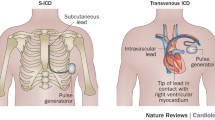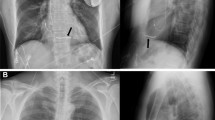Abstract
ICD implantation is today a well-recognized therapy to prevent sudden cardiac death. The available implantable devices at present need the use of permanent endocavitary leads which may cause, in some instances, serious troubles to the patients (lead dislodgement, ventricular perforation, lead infections, etc.). A new implantable defibrillator provided by only a subcutaneous lead is at present under evaluation. Its potential indications, usefulness benefits, and problems represent an interesting field of investigation and discussion. This paper describes the conclusions recently reached by a panel of experts, with regard to the potential role of an implantable subcutaneous defibrillator in the prevention of sudden cardiac death.
Similar content being viewed by others
References
Mirowski, M., Reid, P. R., Mower, M. M., Watkins, L., Gott, V. L., Schauble, J. F., et al. (1980). Termination of malignant ventricular arrhythmias with an implanted automatic defibrillator in human beings. The New England Journal of Medicine, 303, 322–324.
Brodman, R., Fisher, J. D., Furman, S., Johnston, D. R., Kim, S. G., Matos, J. A., et al. (1984). Implantation of automatic cardioverter-defibrillators via median sternotomy. Pacing and Clinical Electrophysiology, 7, 1363–1369.
Fromer, M., Brachmann, J., Block, M., Siebels, J., Hoffmann, E., Almendral, J., et al. (1992). Efficacy of automatic multimodal device therapy for ventricular tachyarrhythmias as delivered by a new implantable pacing cardioverter-defibrillator. Results of a European multicenter study of 102 implants. Circulation, 86, 363–374.
Bardy, G. H., Hofer, B., Johnson, G., Kudenchuk, P. J., Poole, J. E., Dolack, G. L., et al. (1993). Implantable transvenous cardioverter-defibrillators. Circulation, 87, 1152–1168.
Moss, A. J., Hall, W. J., Cannom, D. S., Daubert, J. P., Higgins, S. L., Klein, H., et al. (1996). Improved survival with an implanted defibrillator in patients with coronary disease at high risk for ventricular arrhythmia. The New England Journal of Medicine, 335, 1933–1940.
The Antiarrhythmic versus Implantable Defibrillators (AVID) Investigators (1997). A comparison of antiarrhythmic-drug therapy with implantable defibrillators in patients resuscitated from near-fatal ventricular arrhythmias. The New England Journal of Medicine, 337, 1576–1583.
Connolly, S. J., Gent, M., Roberts, R. S., Dorian, P., Roy, D., Sheldon, R. S., et al. (2000). Canadian Implantable Defibrillator Study (CIDS): a randomized trial of the implantable cardioverter-defibrillator against amiodarone. Circulation, 101, 1297–1302.
Kuck, K. H., Cappato, R., Siebels, J., Rüppel, R., & for the CASH investigators. (2000). Randomized comparison of antiarrhythmic drug therapy with implantable defibrillators in patients resuscitated from cardiac arrest: the Cardiac Arrest Study Hamburg (CASH). Circulation, 102, 748–754.
Buxton, A. E., Lee, K. L., DiCarlo, L., Gold, M. R., Greer, G. S., Prystowsky, E. N., et al. (2000). Electrophysiologic testing to identify patients with coronary artery disease who are at risk for sudden death. The New England Journal of Medicine, 342, 1937–1945.
Jones, G. K., Bardy, G. H., Kudenchuk, P. J., Poole, J. E., Dolack, G. L., Troutman, C., et al. (1995). Mechanical complications after implantation of multiple-lead nonthoracotomy defibrillator systems: implications for management and future system design. American Heart Journal, 130, 327–333.
Kron, J., Herre, J., Renfroe, E. G., Rizo-Patron, C., Raitt, M., Halperin, B., et al. (2001). Lead- and device-related complications in the antiarrhythmics versus implantable defibrillators trial. American Heart Journal, 141, 92–98.
Link, M. S., Hill, S. L., Cliff, D. L., Swygman, C. A., Foote, C. B., Homoud, M. K., et al. (1999). Comparison of frequency in complications of implantable cardioverter-defibrillators in children versus adults. The American Journal of Cardiology, 83, 263–266.
Burke, M. C., Coman, J. A., Cates, A. W., Lindstrom, C. C., Sandler, D., Desai, A., et al. (2005). Feasibility of left chest subcutaneous electrode in terminating ventricular fibrillation. Journal of the American College of Cardiology, 45, 106.
Lehman Brothers Equity Research: Medical Supplies & Devices. Industry overview. US ICD Market: As big as industry suggests? August 21, 2006.
Bardy, G. H., Cappato, R., Smith, W. M., Hood, M., Rissmann, W. J., Gropper, C. M., et al. (2002). The totally subcutaneous ICD system (The S-ICD). Pacing and Clinical Electrophysiology, 24, II–578.
Grace, A. A., Smith, W. M., Hood, M. A., Connelly, D. T., Murgatroyd, F. D., Crozier, I. G., et al. (2005). A prospective, randomized comparison in humans of defibrillation efficacy of a standard transvenous ICD system with a totally subcutaneous ICD system (The S-ICD System). Heart Rhythm, 2, 1036.
Lieberman, R., Havel, W. J., Rashba, E., DeGroot, P. J., Stromberg, K., & Shorofsky, S. R. (2008). Acute defibrillation performance of a novel, non-transvenous shock pathway in adult ICD indicated patients. Heart Rhythm, 5, 28–34.
Acknowledgements
Conflicts of Interest
Dr. Riccardo Cappato is a patent inventor of Cameron Health. Dr. David Steinhaus is Medical Director and VP of CRDM Strategy and Professional Relations Medtronic Inc., Mounds View, MN 55112, USA.
Author information
Authors and Affiliations
Corresponding author
Rights and permissions
About this article
Cite this article
Santini, M., Cappato, R., Andresen, D. et al. Current state of knowledge and experts’ perspective on the subcutaneous implantable cardioverter-defibrillator. J Interv Card Electrophysiol 25, 83–88 (2009). https://doi.org/10.1007/s10840-008-9360-9
Received:
Accepted:
Published:
Issue Date:
DOI: https://doi.org/10.1007/s10840-008-9360-9




